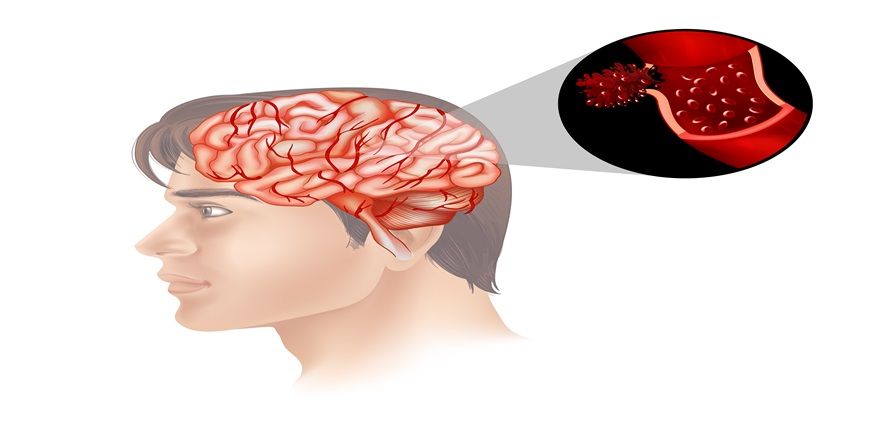A transient ischaemic attack, or mini stroke, is caused when the blood supply to the brain stops temporarily. Generally lasting for only 5 minutes, a TIA can be a symptom of an upcoming stroke. The symptoms of an ischaemic attack tend to resolve themselves within 24 hours. However, as the symptoms of a mini stroke and a stroke are identical, it is crucial to seek medical attention if one experiences them.
What Is a Transient Ischaemic Attack?
Ischaemia is when the flow of blood is restricted to a part of the body, while transient means temporary. A transient ischaemic attack, TIA, or mini stroke is when the blood supply to the brain is temporarily cut off, and without the blood flow, the cells of the brain begin to malfunction and die. While mini stroke symptoms generally last for 5 minutes, there is no actual way to predict how long they may last in individual cases, and each minute counts. More importantly, a mini stroke or TIA does not mean ‘smaller’, as a mini stroke can also permanently affect large areas of the brain and it may even be followed by a stroke at any time from within minutes to within a year.
What Causes the Symptoms of a Transient Ischaemic Attack
The leading cause of the symptoms of an ischaemic attack is blood clots. A clot in an artery that is connected to the brain impedes the flow of blood, preventing the brain from getting the oxygen it requires to function properly. In the case of a TIA, the blood clot is generally temporary and is reabsorbed quickly, which restores the proper flow of blood. Sometimes, TIAs may also be caused by plaque buildup in the arteries, by an air bubble, or in rare cases, by hemorrhage or small amounts of bleeding in the brain.
Risk Factors of Transient Ischaemic Attack
One of the biggest risk factors for TIA and stroke is high blood pressure. Over time, hypertension can damage the arteries, leading to atherosclerosis. The build-up of plaque may also rupture, creating clots in the arteries. There are several other factors that can increase the risk of a TIA or stroke.
Risk Factors that Can be Controlled
- Smoking which can harm the cardiovascular system.
- Diabetes.
- Eating foods that are high in saturated and trans fats.
- High cholesterol.
- Sedentary lifestyle.
- Obesity.
Risk Factors that Cannot be Controlled
- The risk of strokes increases with age, but that does not mean that a stroke cannot affect a younger person.
- Family history of strokes, especially of family members having strokes before the age of 65.
- Females are also at a higher risk of stroke due to factors like pregnancy, preeclampsia, gestational diabetes, postmenopausal hormone therapy, and use of oral contraceptives.
Symptoms of a Minor Stroke
Some of the most noticeable symptoms of a minor stroke are similar to those of a brain stroke. Earlier, the acronym for the symptoms that was used to educate people about the signs of a stroke was F.A.S.T. However, over time, it was realised that several cases of a transient ischaemic attack were being overlooked based on the symptoms described in F.A.S.T, which led to two new variations being created – F.A.S.T.E.R. and B.E.F.A.S.T.E.R. Here’s what all these acronyms mean:
F.A.S.T
- F (Face): Sudden weakness or numbness of the face, leading to drooping, mostly towards only one side.
- A (Arms): Sudden weakness or numbness in the arms, where a person may be unable to raise one or both arms.
- S (Speech): Loss of speech or difficulties in talking or understanding speech.
- T (Time): This is about the criticality to act quickly if an individual starts experiencing symptoms of a minor stroke.
B.E. F.A.S.T.
- B (Balance): Sudden issues with coordination or balance.
- E (Eyes): Sudden blurry vision, seeing double, or a loss of vision in one or both eyes.
- F.A.S.T.: Same as before.
F.A.S.T.E.R.
F and A remain the same as before, while S becomes stability (balance), T is talking (speech), E is eyes, and R is react, which is again a reminder to act quickly.
Other Symptoms
- Sudden severe headache
- Difficulty swallowing
- Confusion
- Hemiplegia
- Sudden partial or total loss of one or more senses
- Dizziness or vertigo
- Memory loss
- Fainting
A transient ischaemic attack or TIA may occur more than once, with every symptom of the TIA varying, depending on the part of the brain that has been affected.
Post TIA Symptoms
Symptoms of a mild stroke may have long-term effects, like:
- Fatigue: People may experience excessive sleepiness that does not get better with rest.
- Emotional Shifts: After having experienced the symptoms of a mild stroke, feelings of shock or anxiety are common.
Mild Stroke Treatment
On experiencing a mini stroke, treatment is crucial for lowering one’s risk of having a stroke in the future. The treatment for a mini stroke is generally based on various factors, like what caused the stroke, where the clot is located, how serious the attack was, and the findings of imaging tests. Some of the common methods of treatment for a mild stroke include:
- Medication: To treat the cause of the TIA and prevent a stroke.
- Anti-platelet and Anticoagulant Drugs: Blood-thinning medication to prevent clots from forming.
- Statins: For lowering cholesterol.
- Blood Pressure Medication: For expanding blood vessels to ensure better flow of blood.
- Endovascular Procedures: Like thrombectomy for removing a blood clot, placing a stent into a narrowed blood vessel to keep it open, or angioplasty to place a balloon in a blood vessel to widen it.
Even though the complications of a transient ischaemic attack seem to fade in a while, it may be a sign of an impending stroke. That is why it is crucial to seek medical attention urgently if one experiences any symptoms that may indicate a TIA or a stroke.













 7982100200
7982100200























 To reach our help desk call 9213188888
To reach our help desk call 9213188888.png)
Comments